The Seth Thomas #18 Tower Clock,
a mechanical
marvel from the 19th century.
In 2024 we are restoring the clock which is remarkably similar to Big Ben
In this video, you can see where our Seth Thomas clock came from, see some of the movement, and hear it tick!
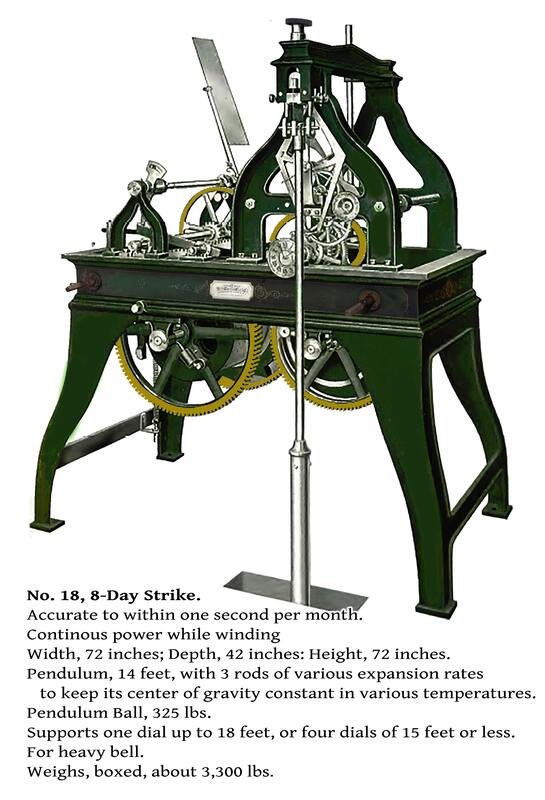 This is how the #18 Seth Thomas clock appeared in their catalog.
This is how the #18 Seth Thomas clock appeared in their catalog.
The Seth-Thomas No. 18 tower clock, came to Ravenna in 1883, the same year that the American railways established standard time zones, and knowing the correct time was becoming a crucial part of modern life. The clock stayed atop the Portage County Courthouse in Ravenna, keeping perfect time, until the Courthouse was demolished in 1960.
Thirteen years after the courthouse was demolished, the clock was officially installed in the clock tower at the Portage County Historical Society. It stayed there until 2022 when the dirty and rusting clock was removed from the tower for restoration and repair.
Thirteen years after the courthouse was demolished, the clock was officially installed in the clock tower at the Portage County Historical Society. It stayed there until 2022 when the dirty and rusting clock was removed from the tower for restoration and repair.
 A page from a Seth Thomas catalog shows how the clock fit into the courthouse. Because the clock was at the top of the courthouse it would have been kept warm in the winter. Today where the courthouse stood is a lawn that faces the current courthouse. The other building Riddle Block # 1, and the flagpole are still there.
A page from a Seth Thomas catalog shows how the clock fit into the courthouse. Because the clock was at the top of the courthouse it would have been kept warm in the winter. Today where the courthouse stood is a lawn that faces the current courthouse. The other building Riddle Block # 1, and the flagpole are still there.
The pictures below were all taken in the PCHS tower. They begin at the tower's ground level, move onto the first platform where the clock movement was, and continue to the top platform where the four clock dials were located.

The 320-pound pendulum is 14 feet long and makes one swing every 2 seconds.
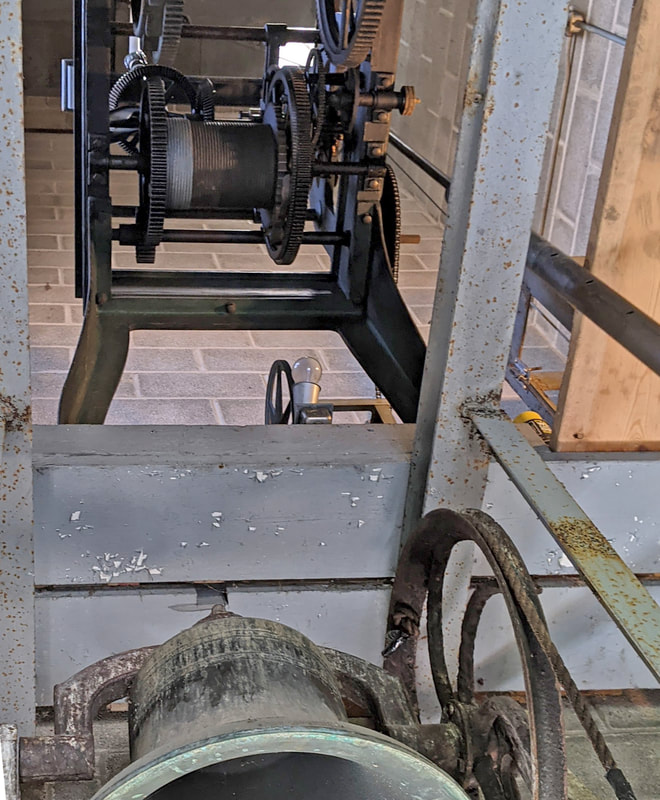
Looking up from the ground level, following the pendulum up to the movement, or heart of the clock, past the original 1831 courthouse bell.

The heavy weight that powers the clock is attached to the cable you see here. The horizontal gear in the upper left slowly rotates the shaft that drives the four sets of hands on the four clock faces in the next level above.

The part of the clock that makes it keep time, or regulates it, is the escapement, which ends in the two ivory rollers in the lower part of the picture. They straddle the top end of the pendulum rod, giving it the impulse needed to keep it swinging in its two-second beat. The rollers are each attached to brass brackets. Each bracket has a flat tab attached to it called a pallet. Six rotating arms (two sets of three) also have pallets at their tips. As the arms rotate, the arm pallets alternately strike the pallets on their respective brackets and momentarily stop the clock movement. This contact is the "tick" sound heard as the clock runs. Because the pallets are angled, they slide apart and the bracket is "pushed," thus pushing the roller, giving the pendulum its impulse. This momentary halt is about one second and can be adjusted by shortening or lengthening the pendulum. It can be very closely adjusted within a few seconds a month. Gallileo Galilei is credited with having developed the physics of a swinging pendulum, in the 16th century.
The escapement that this clock uses was designed for what at the time was the most accurate clock in the world: Big Ben. To design Big Ben, teams of competing engineers worked for six years until the Astronomer Royal awarded the contract to Edmund Denison whose design was something that until that time was considered impossible: accuracy within a second an hour. Big Ben became fully operational in 1859.
To gain a further understanding of how much alike Portage County's Seth Thomas #18 is to the clock that powers Big Ben, please see the movie below.
To gain a further understanding of how much alike Portage County's Seth Thomas #18 is to the clock that powers Big Ben, please see the movie below.
The above movie was excerpted from the excellent, "What's inside Big Ben"
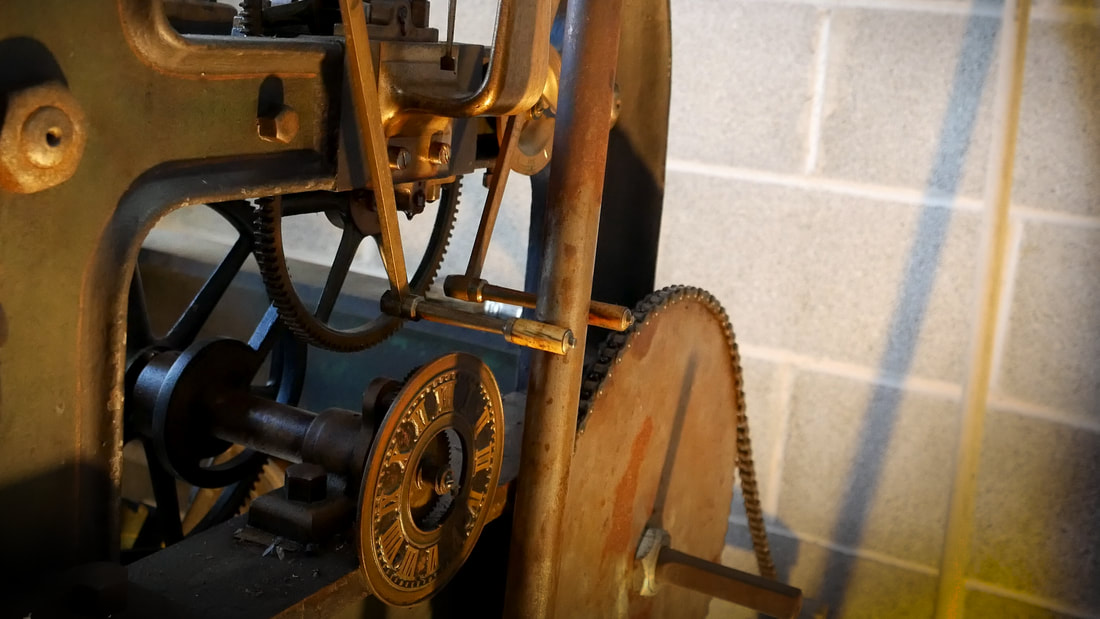
Another view of the ivory rollers that push the pendulum. The chain is connected to an electric motor that automatically winds the clock, by pulling up the weights, about once every 7 days. In the 19th century the clock was hand-wound.
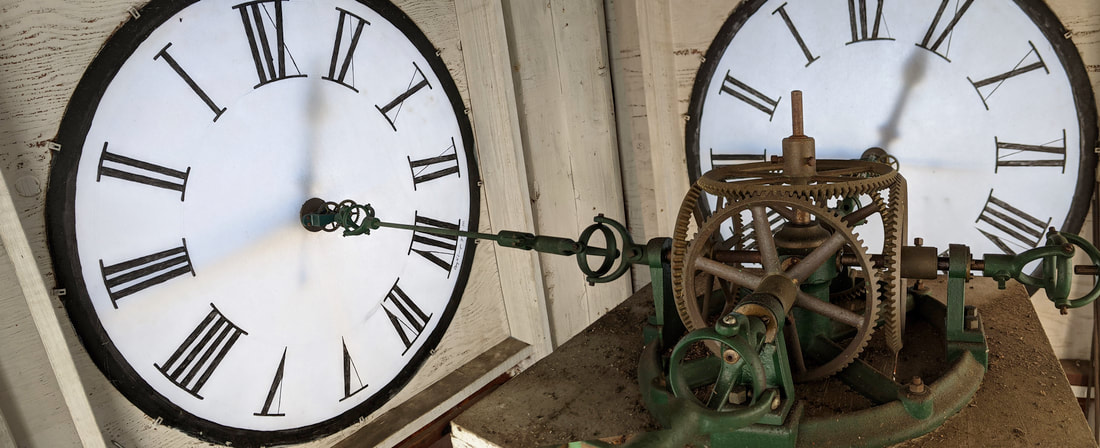
Here, on the upper level, the shaft from the movement, about 10 feet below, engages various gears that turn the four sets of hands.

A closeup of the shaft engaging the dial--turning one hand every hour and the other every 12 hours.
In the movie below, you can see how the movement of the pendulum affects various parts of the clock as well as hear the amazing two-second tick.
If you want to learn more about the clock, you are welcome to download the small booklet we have produced that explains in greater detail how the clock works.
If you want to learn more about the clock, you are welcome to download the small booklet we have produced that explains in greater detail how the clock works.
The clock is durable thanks to the original design and engineering of its maker. The historical society has not decided what is the long-term future of the clock, but in late 2021 it was removed from the tower for cleaning, rust removal, and replacing a few parts. A local horologist, Richard Whitmore, has volunteered to do that work.
For more information regarding this or other clocks please contact:
Richard Whitmore at The American Clock Shop,
822 Cleveland Road, Ravenna OH 44266
[email protected], 330-221-1649.
Richard Whitmore at The American Clock Shop,
822 Cleveland Road, Ravenna OH 44266
[email protected], 330-221-1649.
Step one of clock of restoring the clock was, in late 2021, removing it from the clock tower at the Portage County Historical Society and transporting it to the American Clock Shop. You can see pictures of that, in a new window, here.
From 2021 until early 2024 the work consisted of cleaning and repairing various parts. Some examples of those cleaned parts are below. Special thanks for help in doing this goes to master mechanic and machinist Reggie Riddle.
From 2021 until early 2024 the work consisted of cleaning and repairing various parts. Some examples of those cleaned parts are below. Special thanks for help in doing this goes to master mechanic and machinist Reggie Riddle.
Master machinist Reggie Riddle, left, and horologist Richard Whitmore, right, are seen here working on fastening a part to the frame of the Seth Thomas clock.
Below are before and after pictures of the "distributor" that sits above the clock mechanism and directs the rotation of the shafts that move the hands on the four faces of the clock.
In early 2024 the clock, with only a demonstration pendulum, started ticking again as you can see in this short video.
In the first half of 2024 we hope to have the clock fully assembled and operating in the spacious bay of Flex Storage on Cleveland Road in Ravenna. We'll keep you updated.
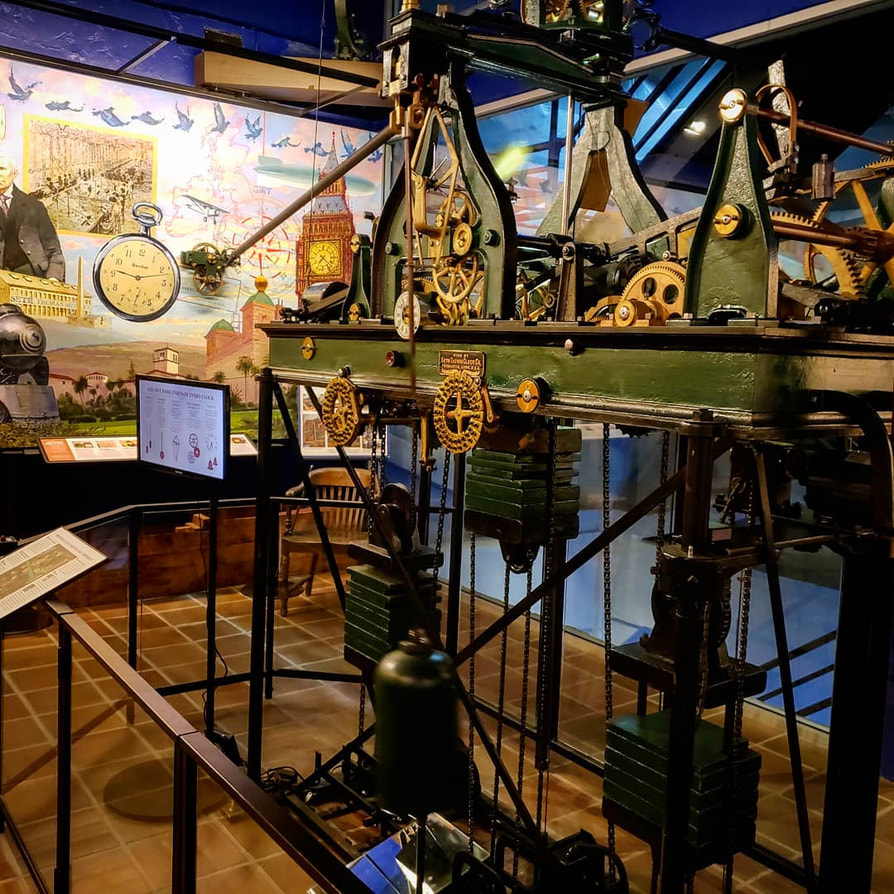 Visitors to the Santa Barbara clock tower have only a railing separating them from a working Seth Thomas clock that was installed in 1929. (Photo credit: http://www.bisnoschallgallery.com/ )
Visitors to the Santa Barbara clock tower have only a railing separating them from a working Seth Thomas clock that was installed in 1929. (Photo credit: http://www.bisnoschallgallery.com/ )
The city of Santa Barbara, California, has done a wonderful job of preserving its Seth Thomas clock.
The story of how the now-empty Portage County Historical Society clock tower was constructed, below, is a tale of community cooperation and generosity. We need a similar effort now to save the clock for future generations.
Before his death in 1970, Mr. Edward Waas, Jefferson Street, Ravenna, Ohio, had promised to give our society the Court House Clock which he purchased for $400 from the contractor who tore down the Portage County Court Houses. Also, Mr. Waas was to give us $500 for the building of a tower for the clock. Since there was no will, we could not validate any claim against the estate. Mr. VanderSteen, neighbor and close friend of Mr. Waas, was first instrumental in contacting and informing the heirs of Mr. Waas of the above facts. Then, through the help of the estate attorneys Mr. Perry Dickinson and Mr. George McClelland, the heirs were all asked and agreed to donate the clock to our society. Since the personal property (clock collection, etc.) of Mr. Waas had already been advertised at auction, trustee Ed Beckwith went to the sale and bid on the clock at $1600, which amount was a tax deduction to all the heirs.
County Engineer, Mr. Paul Shafer, had his bridge crew move all to our new museum building basement. Mr. Beckwith and Mr. James V. Ferry of Kent, Ohio, dismantled the clock on a very cold and wintry day, at Mr. Waas' home. Those men faithfully continued and have followed through to completion the repair, erection, installation and operation of the clock. Also on that cold day, the Record-Courier sent their photographer, Bob Seton, to get pictures; he had to have a tow truck pull his car from a ditch.
Mr. Bob Dix and son, have continued to follow our progress and report all in their Newspaper. That day at Mr. Waas’ we all searched for the original glass dials and hands. The only dial or face found was the glass replacement got by Mr. Paul Krueger for the courthouse in the early 1930's. Two sets of hands were nearby (one broken). I found one set on top of a roof beam, and one set in a dark and narrow dirt crawl space in the basement. Only one set was still good.
Mr. Roger Brown of the Roger Brown Lumber Co., South Chestnut Street, Ravenna, Ohio, made two sets of mahogany wood hands for Ed Beckwith just before he died. Mr. Jim Ferry also made two sets of hands—these four sets are on the dials. Mr. Ferry made new brass rods for the hands, several other new parts, universals and the long aluminum tube drive rod to replace lost and damaged parts. He has straightened, cleaned, polished and painted many small parts and gears. The County Crew carried the assembled clock from our basement and lifted it into place on the planks which we bolted on the steel beams at the 11 foot top level of the tower base in August, 1972. It was sprayed with silicone and covered with plastic. Thus, it was exposed to the weather till the end of June 1973 when the roof was completed. Mr. Howard Kyle and I carried all weights, pendulum rods and bob to the tower. Ed Beckwith and son Gerald installed pendulum and bob and cleaned some rust. The new Plexiglass dials or faces were donated, cut and sandblasted-one side by Mr. Joseph Waranai, Hiram Rapids, Ohio, Mrs. Wesley (Mary) Ensinger, Edinburg, Ohio, painted all dials in reverse on the sandblasted inside with a special paint given by the Red Spot Paint Co. The finished and installed dials were installed on July 23, 1973 by Beckwith, Ferry, Waranai and Plough . Later the scaffold was taken down by masons Saye and Guiletto—marking the finish of two years of outside work.
Most of the bricks, the stone lintels and sill are all from the old Poe family home, North Meridian Street, Ravenna, given by First National Bank and Trust Co. board, by and through J.A. Jones, H. R. Loomis and Morris Evans, when the home was torn down to make a parking lot in 1971. It was all very carefully scooped up by State Road Wrecking Co. of Akron and under the direction of our mason, Mr. Richard Schmidt, and delivered to two sites, our small bank barn and our parking lot. Dick Schmidt and Cy Plough sorted, cleaned and wheeled over 2,000 good and specially selected brick to the tower site through the summer of 1971. We filled the parking lot and the barn bank with the rubble.
The tower was started in June, 1972. The Portage County Welfare sent a man or two from time to time to clean and wheel more brick to site and to help the mason. John Begala and crew were the first to help—we all got poison ivy when the front pear tree was cut down and the other pear tree trimmed. The other brick used are those in the first six courses just above the concrete coping and are from the brick building corner Main & North Water Street, Kent, Ohio, which burned in 1972, and were given to us by the owner Mr. James G. France. They were picked out and delivered by Ed Beckwith. The stained glass window from the H. Warner Riddle Sr. home (now BPOE), East Ravenna was donated by Testa Bros. Construction, Ravenna. The eight wood-corner columns from the old Mabel Dodge family home North Meridian Ravenna, were given by the Second National Bank Board through Mr. William Rastetter and Dick Fischer and taken out by Cy Plough and Jack Salsgiver. The eight-inch fancy tile in the cross from the original Ravenna City Band Stand (present courthouse site) were given by Mr. Dave Porthouse who laid them up over fifty years ago and also helped tear them down about 1959. The metal 24-inch valley tin coping under the cupola was donated and bent at the John Misch shop. It was cut, fabricated and installed and soldered by Mr. Louis Patch, Jr., Ravenna, (his shop is Schmidt Sheet Metal, in Kent, Ohio). The copper roof was donated by Mr. Frank McClintock, Liberty Street, Garrettsville, Ohio, and cut, fabricated and installed by Louis Patch, Jr.
The eagle weather-vane was given by Mr. Lee Havre Jr. and cut off cupola of the Peter K. Bean brick carriage house on East Main, Ravenna, by Cy Plough and son John Plough before the building was torn down in 1968. It had been shot full of holes plus other damages. Now just a breath of air will move the eagle--the arrow and eagle face the direction the wind flows. All inside scaffold was loaned by Dan Hearrell and brother. All outside scaffold and plank loaned by P. L. Prank Construction Co. by Jim and Burt Frank for over 11 months. All electrical work, wire and fittings donated by R. A. Jones Electric, Ravenna, Mr. James Ferry made and donated bronze date and-name plates cast by colonial Pattern Company Kent, Ohio. Stanchions by Mrs. David (Mary Jane Fairchild) Watkins. The 1863 bell with wheel, striker and original clapper delivered by Paul Krueger and given by County commissioners Carl Broderick, Robert Stratton and John Carson. Mr. Krueger gave the wood bell rope wheel from the original 1830 Court House in 1960. He has been our constant advisor on the clock. All welding and steel fabricating was donated and done by Howard (Slim) Stafford, New Milford, Ohio. He donated inside angle, steel top beams, twelve rods, ladder brackets, made and installed ladder, gave iron, fabricated and installed bell frame and bell. Mr. Robbins, of Ravenna City Iron and Steel gave two bottom iron beams, and re-bars. Majority of building material from Bus Willyard, Ravenna Lumber, Smith and Cowan and Stamm Bros. Mr. Joe Waranai made all forms and helped finisher Jack Campbell of Stamm Bros, pour and shape concrete coping in one operation. Joe donated liquid for sealing the coping and it was applied by Cy. All brick, block and corbling and start of cross done by original mason Dick Schmidt of Stow (born and raised in Ravenna), balance of tower by native Ravenna mason Ronald Rogers with some help by Jim McCoy and Jerry Guiletto, tended by Cy Plough, Ron's son and helper. Mason advisors were Dave Porthouse, Dan Hearrell and E. Proehl.
"Corbling" or "stepping in" is the marvel of this tower as there is no structural steel used, the corbled brick must bear the weight of the entire 40-foot super structure. All carpenter work by Joe Waranai helped by Cy Plough and trustee Jack Salsgiver. Carpentry and building advisors were Earl G. Proehl and Joseph Guillozet of Mantua and Cleveland. All inside door trim is original Butternut wood-door trim taken out of 1882 Court House by John Misch & Cy Plough and stored first at Oak Rubber and then in original trustee Ernest Jones' barn. The two doors given by Mr. Wesley Ensinger and wife Mary, Edinburg, Ohio and are from the hotel home in Edinburg owned and run by Mrs. Lucy Rogers Byers and daughter Cora Byers who had both been school teachers. Doors repaired by Oscar Riggenbach at Bus Willyard's and painted by trustee John Wanchick. John also painted inside cases and steel. Used steel chipped, scraped, brushed and painted by Cy Plough. Ladder and all inside and outside of cupola painted by Cy. Architects Edward W. Prusak and Joseph Spataro of Ravenna, donated their work and help since the start in 1971. Footer laid out by Dick Schmidt and dug by Cy Plough, May, 1972.
The tower was completed in September, 1973. Original clock committee members were Ed Beckwith and Jim Ferry who started, regulated and kept clock running as of Sunday, September 23, 1973. Mr. B. P. Strong, Atwater, Ohio is to donate and install motor, etc. to automatically wind clock time weights. Since the clock will not strike, those weights will always rest on floor. Mr. Waranai made and installed two display cases for exhibits. We also have the original Lady Justice repaired by Hugo Beitz and the large original stained glass window from the courthouse in the new museum building. It was by and through original and continuing donors, Mr. Earl G. Proehl, Ravenna and original trustee Emmet J. Kline's sons Maurice, Francis, and Ralph, that this has been possible. Thanks to other contributors who helped out.
Portage County Historical Society



